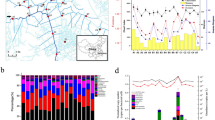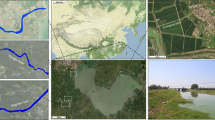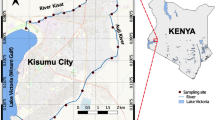Abstract
Risks of pathogenic bacteria to the health of both human beings and water ecosystems have been widely acknowledged. However, traditional risk assessment methods based on fecal indicator bacteria and/or pure culture are not comprehensive at the community level, mainly owing to the limited taxonomic coverage. Here, we combined the technique of high-throughput sequencing and the concept of metacommunity to assess the potential pathogenic bacterial communities in an economically and ecologically crucial but highly polluted river—the North Canal River (NCR) in Haihe River Basin located in North China. NCR presented a significant environmental gradient, with the highest, moderate, and lowest levels of pollution in the up-, middle, and downstream. After multiple analyses, we successfully identified 48 genera, covering nine categories of potential pathogens (mainly human pathogens). The most abundant genus was Acinetobacter, which was rarely identified as a pathogen bacterium in previous studies of NCR. At the community level, we observed significant geographical variation of community composition and structure. Such a high level of geographical variation was mainly derived from differed abundance of species among sections along the river, especially the top seven Operational Taxonomic Units (OTUs). For example, relative abundance of OTU1 (Gammaproteobacteria/Acinetobacter) increased significantly from upstream towards downstream. Regarding the underlying mechanisms driving community geographical variation, environmental filtering was identified as the dominant ecological process and total nitrogen as the most influential environmental variable. Altogether, this study provided a comprehensive profile of potential pathogenic bacteria in NCR and revealed the underlying mechanisms of community succession. Owing to their high abundance and wide geographical distribution, we suggest that potential pathogens identified in this study should be incorporated into future monitoring and management programs in NCR. By revealing the correlation between environmental factors and community composition, the results obtained in this study have significant implications for early warning and risk assessment of potential pathogen bacteria, as well as management practices in highly polluted river ecosystems.





Similar content being viewed by others
Data accessibility
The high-throughput sequencing data have been deposited into NCBI Sequence Read Archive (SRA) (accession no.: PRJNA504486).
References
Abraham, W.R. 2010. Megacities as sources for pathogenic bacteria in rivers and their fate downstream. International Journal of Microbiology 2011: 798292.
Al Atrouni, A., M.L. Joly-Guillou, M. Hamze, and M. Kempf. 2016. Reservoirs of non-baumannii Acinetobacter species. Frontiers in Microbiology 7: 49.
Almasaudi, S.B. 2018. Acinetobacter spp. as nosocomial pathogens: Epidemiology and resistance features. Saudi Journal of Biological Sciences 25: 586–596.
Blanchet, F.G., P. Legendre, and D. Borcard. 2008. Forward selection of explanatory variables. Ecology 89: 2623–2632.
Borcard, D., and P. Legendre. 2002. All-scale spatial analysis of ecological data by means of principal coordinates of neighbor matrices. Ecological Modelling 153: 51–68.
Borcard, D., P. Legendre, and P. Drapeau. 1992. Partialling out the spatial component of ecological variation. Ecology 73: 1045–1055.
Cabral, J.P. 2010. Water microbiology. Bacterial pathogens and water. International Journal of Environmental Research and Public Health 7: 3657–3703.
Caporaso, J.G., C.L. Lauber, W.A. Walters, D. Berg-Lyons, C.A. Lozupone, P.J. Turnbaugh, N. Fierer, and R. Knight. 2011. Global patterns of 16S rRNA diversity at a depth of millions of sequences per sample. Proceedings of the National Academy of Sciences 108: 4516–4522.
Chen, C., M. Wang, J. Wang, S. Tan, R. Cheng, X. Zheng, Y. Wei, and Y. Wang. 2017. Health risk assessment based on indicator microorganisms in Wenyu River. Acta Scientiae Circumstantiae 37: 3177–3184 (in Chinese, English summary).
Chen, C., L. Li, X. Zhi, P. Zhang, Y. Dai, Y. Xiao, and Z. Shen. 2019. Pollution characteristics and health risk assessment of microorganism pollutions in the Beiyun River. Environmental Science 40: 633–639 (in Chinese, English summary).
Downes, B.J. 2010. Back to the future: Little-used tools and principles of scientific inference can help disentangle effects of multiple stressors on freshwater ecosystems. Freshwater Biology 55: 60–79.
Dudgeon, D., A.H. Arthington, M.O. Gessner, Z.I. Kawabata, D.J. Knowler, C. Lévêque, R.J. Naiman, A.H. Prieur-Richard, et al. 2006. Freshwater biodiversity: Importance, threats, status and conservation challenges. Biological Reviews 81: 163–182.
Edberg, S.C.L., E.W. Rice, R.J. Karlin, and M.J. Allen. 2000. Escherichia coli: The best biological drinking water indicator for public health protection. Journal of Applied Microbiology 88: 106S–116S.
Edgar, R.C. 2013. UPARSE: Highly accurate OTU sequences from microbial amplicon reads. Nature Methods 10: 996.
Field, K.G., and M. Samadpour. 2007. Fecal source tracking, the indicator paradigm, and managing water quality. Water Research 41: 3517–3538.
Göthe, E., D.G. Angeler, and L. Sandin. 2013. Metacommunity structure in a small boreal stream network. Journal of Animal Ecology 82: 449–458.
Heeb, F., H. Singer, B. Pernet-Coudrier, W. Qi, H. Liu, P. Longrée, B. Müller, and M. Berg. 2012. Organic micropollutants in rivers downstream of the megacity Beijing: Sources and mass fluxes in a large-scale wastewater irrigation system. Environmental Science and Technology 46: 8680–8688.
Heino, J., A.S. Melo, and L.M. Bini. 2015. Reconceptualising the beta diversity-environmental heterogeneity relationship in running water systems. Freshwater Biology 60: 223–235.
Ibekwe, A.M., M. Leddy, and S.E. Murinda. 2013. Potential human pathogenic bacteria in a mixed urban watershed as revealed by pyrosequencing. PLoS ONE 8: e79490.
James, E., and M. Joyce. 2004. Assessment and management of watershed microbial contaminants. Critical Reviews in Environmental Science and Technology 34: 109–139.
Jiang, S.C., and W. Chu. 2004. PCR detection of pathogenic viruses in southern California urban rivers. Journal of Applied Microbiology 97: 17–28.
Jin, D., X. Kong, B. Cui, S. Jin, Y. Xie, X. Wang, and Y. Deng. 2018. Bacterial communities and potential waterborne pathogens within the typical urban surface waters. Scientific Reports 8: 13368.
Legendre, P. 2008. Studying beta diversity: Ecological variation partitioning by multiple regression and canonical analysis. Journal of Plant Ecology 1: 3–8.
Leibold, M.A., M. Holyoak, N. Mouquet, P. Amarasekare, J.M. Chase, M.F. Hoopes, R.D. Holt, J.B. Shurin, et al. 2004. The metacommunity concept: A framework for multi-scale community ecology. Ecology Letters 7: 601–613.
Li, X., D. Meng, J. Li, H. Yin, H. Liu, X. Liu, C. Cheng, Y. Xiao, et al. 2017. Response of soil microbial communities and microbial interactions to long-term heavy metal contamination. Environmental Pollution 231: 908–917.
Louca, S., L.W. Parfrey, and M. Doebeli. 2016. Decoupling function and taxonomy in the global ocean microbiome. Science 353: 1272–1277.
Martiny, J.B.H., B.J. Bohannan, J.H. Brown, R.K. Colwell, J.A. Fuhrman, J.L. Green, M.C. Horner-Devine, M. Kane, et al. 2006. Microbial biogeography: Putting microorganisms on the map. Nature Reviews Microbiology 4: 102.
Maugeri, T.L., M. Carbone, M.T. Fera, G.P. Irrera, and C. Gugliandolo. 2004. Distribution of potentially pathogenic bacteria as free living and plankton associated in a marine coastal zone. Journal of Applied Microbiology 97: 354–361.
Oksanen, J., F.G. Blanchet, R. Kindt, P. Legendre, P.R. Minchin, R.B. O’hara, G.L. Simpson, P. Solymos, et al. 2013. Package ‘vegan’. Community ecology package, version, 2.9.
Pandey, P.K., P.H. Kass, M.L. Soupir, S. Biswas, and V.P. Singh. 2014. Contamination of water resources by pathogenic bacteria. AMB Express 4: 51.
Peng, H., W. Xiong, and A. Zhan. 2018. Fine-scale environmental gradients formed by local pollutants largely impact zooplankton communities in running water ecosystems. Aquatic Biology 27: 43–53.
Pernet-Coudrier, B., W. Qi, H. Liu, B. Müller, and M. Berg. 2012. Sources and pathways of nutrients in the semi-arid region of Beijing-Tianjin, China. Environmental Science and Technology 46: 5294–5301.
Pianetti, A., W. Baffone, F. Bruscolini, E. Barbieri, M.R. Biffi, L. Salvaggio, and A. Albano. 1998. Presence of several pathogenic bacteria in the Metauro and Foglia rivers (Pesaro-Urbino, Italy). Water Research 32: 1515–1521.
R Core Team. 2015. R: A language and environment for statistical computing. Vienna: R Foundation for Statistical Computing.
Rathinavelu, S., Y. Zavros, and J.L. Merchant. 2003. Acinetobacter lwoffii infection and gastritis. Microbes and Infection 5: 651–657.
Regalado, N.G., G. Martin, and S.J. Antony. 2009. Acinetobacter lwoffii: Bacteremia associated with acute gastroenteritis. Travel Medicine and Infectious Disease 7: 316–317.
Santo Domingo, J.W., D.G. Bambic, T.A. Edge, and S. Wuertz. 2007. Quo vadis source tracking? Towards a strategic framework for environmental monitoring of fecal pollution. Water Research 41: 3539–3552.
Soininen, J., J. Heino, and J. Wang. 2018. A meta-analysis of nestedness and turnover components of beta diversity across organisms and ecosystems. Global Ecology and Biogeography 27: 96–109.
Tolonen, K.T., Y. Cai, A. Vilmi, S.M. Karjalainen, T. Sutela, and J. Heino. 2018. Environmental filtering and spatial effects on metacommunity organization differ among littoral macroinvertebrate groups deconstructed by biological traits. Aquatic Ecology 52: 119–131.
Vannote, R.L., G.W. Minshall, K.W. Cummins, J.R. Sedell, and C.E. Cushing. 1980. The river continuum concept. Canadian Journal of Fisheries and Aquatic Sciences 37: 130–137.
Vital, M., D. Stucki, T. Egli, and F. Hammes. 2010. Evaluating the growth potential of pathogenic bacteria in water. Applied and Environmental Microbiology 76: 6477–6484.
Wang, J., M. Kang, X. Zheng, C. Chen, M. Wang, B. Xiao, Z. Zhou, Y. Wei, et al. 2017. Occurrence and temporal-spatial distribution of fecal indicator microorganisms in three rivers of the Haihe River Basin. Acta Scientiae Circumstantiae 37: 138–145 (in Chinese, English summary).
Wang, Q., G.M. Garrity, J.M. Tiedje, and J.R. Cole. 2007. Naive Bayesian classifier for rapid assignment of rRNA sequences into the new bacterial taxonomy. Applied and Environmental Microbiology 73: 5261–5267.
Wilkes, G., J. Brassard, T.A. Edge, V. Gannon, C.C. Jokinen, T.H. Jones, N. Neumann, K.D.M. Pintar, et al. 2013. Bacteria, viruses, and parasites in an intermittent stream protected from and exposed to pasturing cattle: Prevalence, densities, and quantitative microbial risk assessment. Water Research 47: 6244–6257.
Wilkes, G., T.A. Edge, V.P.J. Gannon, C. Jokinen, E. Lyautey, N.F. Neumann, N. Ruecker, A. Scott, et al. 2011. Associations among pathogenic bacteria, parasites, and environmental and land use factors in multiple mixed-use watersheds. Water Research 45: 5807–5825.
Xiong, W., J. Li, Y. Chen, B. Shan, W. Wang, and A. Zhan. 2016. Determinants of community structure of zooplankton in heavily polluted river ecosystems. Scientific Reports 6: 22043.
Xiong, W., P. Ni, Y. Chen, Y. Gao, B. Shan, and A. Zhan. 2017. Zooplankton community structure along a pollution gradient at fine geographical scales in river ecosystems: The importance of species sorting over dispersal. Molecular Ecology 26: 4351–4360.
Yang, F., L. Huang, L. Li, Y. Yang, D. Mao, and Y. Luo. 2017. Discharge of KPC-2 genes from the WWTPs contributed to their enriched abundance in the receiving river. Science of the Total Environment 581: 136–143.
Yang, Y., Y. Deng, and L. Cao. 2016. Characterising the interspecific variations and convergence of gut microbiota in Anseriformes herbivores at wintering areas. Scientific Reports 6: 32655.
Yang, Y., Y. Gao, X. Huang, P. Ni, Y. Wu, Y. Deng, and A. Zhan. 2019a. Adaptive shifts of bacterioplankton communities in response to nitrogen enrichment in a highly polluted river. Environmental Pollution 245: 290–299.
Yang, Y., S. Li, Y. Gao, Y. Chen, and A. Zhan. 2019b. Environment-driven geographical distribution of bacterial communities and identification of indicator taxa in Songhua River. Ecological Indicators 101: 62–70.
Yang, Y., P. Ni, Y. Gao, W. Xiong, Y. Zhao, and A. Zhan. 2018. Geographical distribution of zooplankton biodiversity in highly polluted running water ecosystems: Validation of fine-scale species sorting hypothesis. Ecology and Evolution 8: 4830–4840.
Yang, Y., Y. Wei, X. Zheng, Y. Wang, M. Yu, Q. Xiao, D. Yu, et al. 2012. Investigation of microbial contamination in Wenyu River of Beijing. Acta Scientiae Circumstantiae 32: 9–18 (in Chinese, English summary).
Zeglin, L.H. 2015. Stream microbial diversity in response to environmental changes: Review and synthesis of existing research. Frontiers in Microbiology 6: 454.
Zhan, A., S.A. Bailey, D.D. Heath, and H.J. MacIsaac. 2014. Performance comparison of genetic markers for high-throughput sequencing-based biodiversity assessment in complex communities. Molecular Ecology Resources 14: 1049–1059.
Zhu, Y., T.A. Johnson, J. Su, M. Qiao, G. Guo, R.D. Stedtfeld, S.A. Hashsham, and J.M. Tiedje. 2013. Diverse and abundant antibiotic resistance genes in Chinese swine farms. Proceedings of the National Academy of Sciences 110: 3435–3440.
Acknowledgements
Great thanks to Yangchun Gao and Xuena Huang for help during the field sampling, and Ping Ni for assistance in the measurement of water parameters. This work was supported by the National Nature Science Foundation of China [Grant Nos.: 31800419; 31572228], the Water Pollution Control and Treatment Special Project [Grant No.: 2018ZX07105-001], National Key R&D Program of China [Grant No.: 2016YFC0500406], the Innovation in Cross-functional Team Program of the Chinese Academy of Sciences [Grant No.: No.: 2015], Chinese Academy of Science [Grant No.: ZDRW-ZS-2016-5], and the State Key Joint Laboratory of Environment Simulation and Pollution Control [RCEES, Chinese Academy of Sciences; Grant No.: 15K01ESPCR].
Author information
Authors and Affiliations
Corresponding authors
Additional information
Publisher's Note
Springer Nature remains neutral with regard to jurisdictional claims in published maps and institutional affiliations.
Electronic supplementary material
Below is the link to the electronic supplementary material.
Rights and permissions
About this article
Cite this article
Yang, Y., Hou, Y., Ma, M. et al. Potential pathogen communities in highly polluted river ecosystems: Geographical distribution and environmental influence. Ambio 49, 197–207 (2020). https://doi.org/10.1007/s13280-019-01184-z
Received:
Revised:
Accepted:
Published:
Issue Date:
DOI: https://doi.org/10.1007/s13280-019-01184-z




